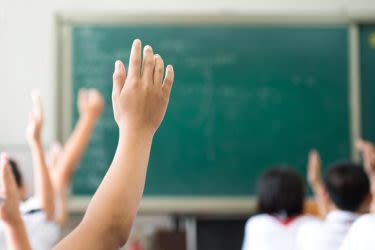Vision problems of school-age children

Your child's vision is essential to their success in school. When their vision suffers, chances are their school work does, too.
Vision problems are common among school-age kids. According to some studies, one in four school-age children have vision problems that, if left untreated, can affect learning ability, personality and adjustment in school.
School-age children also spend a lot of time in recreational activities that require good vision. After-school sports or playing in the back garden aren't as fun if you can't see well.
Warning signs of vision problems in kids
Refractive errors are the most common cause of vision problems among school-age children. Parents, as well as teachers, should be aware of these 10 signs that a child's vision needs correction:

Blurry vision may be interfering with your child's ability to learn in school. Regular eye exams can detect and correct this and other vision problems.
Consistently sitting too close to the TV or holding a book too close
Losing their place while reading or using a finger to guide their eyes when reading
Squinting or tilting the head to see better
Frequent eye rubbing
Sensitivity to light and/or excessive tearing
Closing one eye to read, watch TV or see better
Avoiding activities which require near vision, such as reading or homework, or distance vision, such as participating in sports or other recreational activities
Complaining of headaches or tired eyes
Avoiding using a computer, because it "hurts my eyes"
Receiving lower than usual marks at school
Schedule an appointment with an optometrist if your child exhibits any of these signs. A visit may reveal that your child has myopia (short sightedness), hyperopia (long sightedness) or astigmatism. These common refractive errors are easily corrected with glasses or contact lenses.
DON'T LET POOR VISION HOLD YOUR CHILD BACK: Find an optometrist near you and book an appointment.
Learning disabilities
Learning disabilities (LD) are another concern with school-age children. According research published in Science Daily in 2013, learning disorders affect at least 1 in 10 schoolchildren in Australia and New Zealand.
Learning disabilities are psychological disorders that affect learning; they are not vision problems. Learning-related vision problems sometimes can coexist with LD or be associated with learning disabilities.
In fact, a recent study conducted by researchers at the Mayo Clinic found that children with binocular vision problems (intermittent exotropia and convergence insufficiency) were significantly more likely to be diagnosed with learning disabilities and attention deficit hyperactivity disorder (ADHD) than children with normal eye alignment.
If your child frequently reverses letters while reading or writing, exhibits poor handwriting, dislikes or has difficulty with reading, writing or numeracy, consistently mistakes his left for his right or vice versa, can't verbally express himself or consistently behaves inappropriately in social situations, then seek help.
A multidisciplinary approach usually is the best way to find the cause of learning problems. Consultation with your child's teacher should be the first step. It's also wise to consult an optometrist who specialises in eye tests for children and your GP or paediatrician for additional advice and possible referral to specialists.
Eye exams: how often?
According to Optometry Australia, school-age children need an exam every year if they have visual problems and every second year if no problem has been detected. If they are under 7 years, with a binocular vision anomaly or corrected refractive error or, if between 7-15 years with a binocular vision anomaly or rapidly progressing myopia then they should have an eye exam as recommended by their practitioner.
Frequent eye tests are important because during the school years your child's glasses prescription can change frequently.
Your optometrist will also ensure that your child has the visual skills required for success in school and sports, such as accurate and comfortable eye teaming, peripheral vision, ease of focusing from distance to near and hand-eye coordination.
The problem with vision screenings
Keep in mind that a vision screening performed by your GP or at school is not a comprehensive eye exam. These screenings are designed to alert parents to the possibility of a visual problem, but not take the place of a visit to an optometrist.
Vision screenings are helpful, but they can miss serious vision problems that your eye care practitioner would catch. A child who can see the 6/6 (20/20) line on a visual acuity chart can still have vision problems, and the visual skills needed for reading and learning are much more complex than identifying letters on a wall chart.
Also, children who fail vision screenings often don't get the vision care they need. Two studies published by the American Academy of Ophthalmology found that 40 to 67 percent of children who fail a vision screening do not receive the recommended follow-up care by an optometrist.
One reason for this lack of compliance is poor communication with parents who may or may not be present at the screening. One study found that two months later, 50 percent of parents were unaware their child had failed a vision screening.
The best way to make sure your child has the visual skills he needs to excel in and outside the classroom is to schedule routine comprehensive eye exams with an optometrist who specialises in children's vision.
Page published on Monday, 16 March 2020






